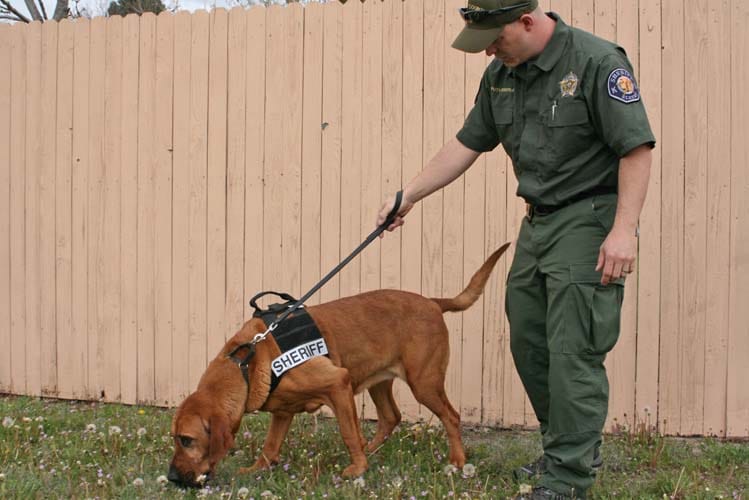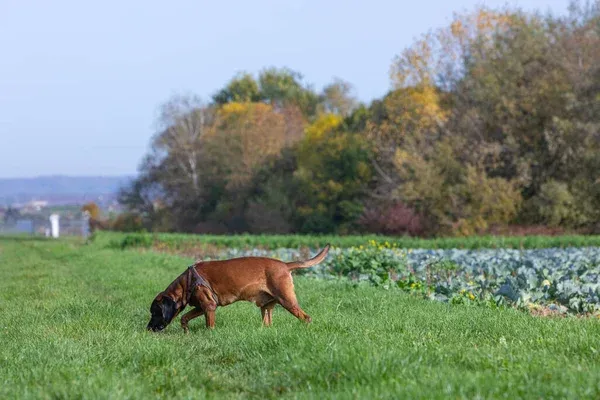Bloodhounds are renowned for their exceptional ability to track scents over long distances, making them invaluable in search and rescue operations as well as in law enforcement. Known for their keen sense of smell, bloodhounds can follow a trail for days and over great terrains. Their olfactory acuity is the result of a distinctive physiological makeup, with a large proportion of their brain dedicated to analyzing smells.

The tracking process begins when a bloodhound sniffs a scent article, such as a piece of clothing, allowing it to lock onto the unique combination of scents associated with the individual it is tasked to find. This dog's olfactory system can distinguish individual components of a complex scent, thanks to their approximately 300 million scent re
ceptors. When on the trail, a bloodhound will keep its nose close to the ground to pick up the nuances of the scent, even if it has been diluted or altered by the elements over time.
Their tracking ability is supported by their physical endurance and loose, wrinkled skin, which helps capture more scent particles. Bloodhounds are relentless trackers, showcasing determination and focus as they follow a scent path. This dedication combined with their tracking prowess makes the bloodhound a powerful ally in locating missing persons or tracking down fugitives. Their work significantly contributes to the success of various investigative efforts, reflecting the remarkable capabilities these dogs possess in scent tracking.

The Bloodhound: An Overview
The Bloodhound is a distinguished breed revered for its unparalleled scent-tracking ability, which is a product of its history, physical makeup, and temperament.
History and Origin
Bloodhounds have a storied past, with roots tracing back to medieval Europe where they were developed to track game and humans. They emerged from early scent hounds to become what they are today: exceptional trackers with a strong lineage. Key in their history are the monks of St. Hubert in Belgium, who are believed to have been instrumental in refining the breed before it spread to England and the rest of the world.
Physical Characteristics
Physical traits of Bloodhounds include a noble stature with a height ranging from 23 to 27 inches and a weight between 80 to 110 pounds. Coat colors typically present as liver and tan or black and tan. Their coat is short but dense, designed to provide protection in dense underbrush. A Bloodhound's nose is one of their most prominent features, with an exceptional sense of smell. The long, drooping ears also aid in picking up scents by sweeping scent particles towards the nose.
| Characteristic | Detail |
|---|---|
| Height | 23-27 inches |
| Weight | 80-110 pounds |
| Coat Colors | Liver and tan, Black and tan |
| Special Feature | Advanced sense of smell |
Temperament and Behavior
Bloodhounds are known for their gentle temperament, making them well-suited as family pets. Despite their power and size, they exude a patient and good-natured behavior around children and adults alike. Bred as scent hounds, their behavior is largely influenced by their strong instinct to follow scents, which can sometimes lead to distraction during training or daily activities. Their persistence and determination in scent tracking are unmatched, often leading them to be employed by law enforcement for tracking missing persons.
The Science of Scent Tracking
Bloodhounds are renowned for their ability to follow a scent trail over long distances and through challenging conditions. This aptitude stems from their exceptional olfactory system designed to detect and process a wide range of scents.
Scent Reception
A bloodhound's nose is its primary tool for scent tracking. The scent is composed of microscopic particles known as skin rafts which are constantly shed by humans and animals. When a bloodhound inhales, these particles, carrying the scent, are trapped in the scent receptors within the nasal cavity. The olfactory receptors, numbering up to 300 million in bloodhounds, dwarf the approximately 5 million in humans, allowing the dogs to pick up even the faintest of scents.
Olfactory Capabilities
Bloodhounds have a highly developed olfactory bulb, the part of the brain responsible for processing smell. The large size of the olfactory bulb in comparison to the overall brain size indicates the superiority of a bloodhound's sense of smell. This specialization allows the olfactory receptors to create a detailed odor image which is a mental representation of the scent. The resolution of this odor image is so precise that bloodhounds can track a scent trail for up to 130 miles and over land, water, and various surfaces.
Scent Discrimination
Bloodhounds excel at scent discrimination, meaning they can isolate and identify a single scent from a mixture of many. They can follow a specific track, even in environments contaminated by countless other scents. A bloodhound distinguishes these tracks through a combination of factors, including the concentration of scent particles, the rate of skin raft shedding, and the uniqueness of the scent compared to others in the environment. This capability is vital in various applications such as search and rescue missions and law enforcement operations.
Training Bloodhounds for Tracking
Training a bloodhound for tracking involves systematic techniques and a strong partnership between the dog and handler, reinforced through consistent practice. Mastery of scent tracking is achieved by honing the bloodhound's natural abilities.
Training Techniques
Bloodhounds possess an innate ability to follow scent trails. Specific training methods are designed to harness this ability. Starting with simple exercises, trainers lay a short scent trail and encourage the bloodhound to follow it, using a combination of verbal cues and treats.
As training progresses, these trails become more complex and longer, often involving different terrains and aging periods to simulate real tracking conditions. The use of a harness and long lead is common during such exercises, allowing the bloodhound to navigate freely while still under the control of the handler.
- Primary Training Tools:
- Harness and lead
- Scent articles
- Treats for positive reinforcement
Handler and Hound Partnership
The partnership between the bloodhound and their handler is crucial to successful tracking. A deep bond and mutual trust must be established, with the handler learning to read the bloodhound's body language and signals. Handlers must remain consistent in their commands and praise to maintain clear communication. Partnership is further reinforced by:
- Spending quality time together beyond training sessions.
- The handler remaining patient and calm throughout the training process.
Practice and Reinforcement
Regular practice is essential to reinforce the bloodhound's tracking skills. Repetition of tracking exercises ensures the bloodhound remains familiar with different scents and environments. Positive reinforcement, such as praise or treats, is used to motivate and reward the bloodhound for successful tracking. This reinforcement solidifies the desired behavior, making the bloodhound eager to track and adept at following even faint or complicated scent trails.

Key to Reinforcement:
- Frequency: Regular, consistent practice sessions.
- Rewards: Immediate praise or treats following successful tracking.
- Gradual Increase in Difficulty: Introducing more challenging tracks over time to enhance the bloodhound's capabilities.
Bloodhound Tracking in Action
Bloodhound tracking is a specialized field where these dogs use their keen sense of smell to follow trails over long distances, frequently aiding in search and rescue operations and criminal pursuit by law enforcement.
Search and Rescue Efforts
Bloodhounds are invaluable assets in search and rescue missions. They play a crucial role in locating missing persons, often navigating challenging terrain. These dogs swiftly pick up a scent from a personal article and meticulously follow it. In many search and rescue scenarios, the bloodhound's tracking ability has been pivotal, with law enforcement agencies and search and rescue organizations employing their skills.
- Terrain Navigation: Trails over rough, forested, or urban areas.
- Scent Discrimination: Ability to isolate the missing person's scent.
Law Enforcement and Criminal Tracking
Within law enforcement, bloodhounds are heralded for their capacity to track criminals. Police units work closely with trained bloodhounds to trace the paths that suspects may have taken. A bloodhound's scenting abilities allow the police force to collect vital clues and can lead to the successful apprehension of individuals.
- Evidence Discovery: Locating items touched by suspects.
- Track Completion: Lead police to real-time locations of fleeing suspects.
Bloodhounds have been known to follow trails that are days old, demonstrating their exceptional tracking prowess that is indispensable to modern policing efforts.
Comparative Tracking Abilities
Bloodhounds excel in scent discrimination and have unparalleled tracking abilities compared to other breeds. Their skill in following a scent trail is legendary and has been crucial in various search and rescue operations.
Bloodhounds Vs. Other Breeds
Bloodhounds possess a highly sophisticated sense of smell, allowing them to follow trails that are days old. Their olfactory acuity is such that they can distinguish between a vast number of individual scents and follow the faintest of trails over long distances.
German Shepherds, while known for their intelligence and versatility, mostly excel in protection and police work rather than specific scent-tracking tasks. Their tracking abilities are formidable but generally not as specialized or as finely tuned to scent discrimination as those of bloodhounds.
Beagles, frequently employed in detection roles such as contraband sniffing, demonstrate a keen sense of smell. However, their abilities tend to be more effective in active searching over smaller areas rather than the long-distance tracking where bloodhounds specialize.
Foxhounds and Coonhounds are also scent hounds with notable tracking capabilities. They traditionally assist hunters by following the scent of game. These breeds are robust and have excellent stamina, but when it comes to scent sensitivity and the ability to untangle complex scent trails, they typically do not match the proficiency of bloodhounds.
- Bloodhound
- Specialization: Long-distance trailing and scent discrimination
- Strengths: Unmatched endurance and concentration in following trails
- Scent Trail: Expertise in identifying aged trails over complex terrain
- Other Hounds
- Specialization: Hunting assistance, property guarding, and contraband detection
- Strengths: Good olfactory sense suitable for active, target-focused searching
- Scent Trail: More effective over shorter distances and with fresher scent trails
While many breeds exhibit tracking dog capabilities, the bloodhound's breed-specific attributes make it a foremost contender in tracking over long distances and through challenging conditions.
Challenges and Considerations in Tracking
When tracking with bloodhounds, understanding the complexities of environmental factors, the limits of training, and the role of technology is essential.
Environmental Factors
The environment plays a significant role in the efficacy of a bloodhound's tracking ability. Diverse terrains such as dense forests or urban settings can affect the scent dispersion. For instance, wet conditions may enhance scent availability, while dry, windy environments might disperse or erode a scent quickly, making the trail difficult to follow.
Furthermore, extreme temperatures can challenge the dog's physical capabilities, with high heat potentially leading to scent evaporation and cold conditions resulting in a cold trail where scents are less volatile.
- Wet Conditions: Enhance scent retention.
- Dry/Windy: Disperse or erode scent.
- Extreme Temperatures: Affect scent volatility and dog's endurance.
Training Limitations
Training a bloodhound for tracking is a nuanced process that demands time and patience. They must learn to distinguish and prioritize the specific scent they are tracking over the myriad of environmental odors. However, training has limitations. Even the most well-trained bloodhound can encounter difficulties with contaminated trails, where multiple scents are intermixed, or follow an aging trail that has degraded over time.
Moreover, there's a balance to be struck in training intensity; a bloodhound needs to be persistent but not to the point of exhaustion or losing accuracy in tracking.
- Contaminated Trails: Multiple scents can confuse the dog.
- Aging Trails: Older trails may present less detectable scents.
- Training Intensity: Must be managed to prevent exhaustion or inaccuracy.
Technological Advances
Technology in tracking has evolved to support bloodhounds' natural abilities. GPS and scent preservation methods can enhance a bloodhound's tracking success. However, reliance on technology should not overshadow the importance of a bloodhound's innate tracking skills.
GPS units can plot a track but require careful handling to ensure accuracy and efficiency. Additionally, technology may assist in analyzing historical data on trails taken which can inform better training practices or search strategies.
- GPS Tracking: Assists with plotting and following a track.
- Scent Preservation: Can extend the life of a scent for training or tracking.
- Innovative training tools: Support data analysis and improve training methods.
Caring for a Bloodhound
Bloodhounds require dedicated care to maintain their health and accommodate their high exercise needs. They are prone to certain health conditions, making regular veterinary care essential.

Health and Lifespan
A Bloodhound typically lives between 10 to 12 years. Regular veterinary check-ups are crucial to manage common health issues such as ear infections and hip dysplasia.
- Bloat (Gastric Torsion): They are particularly susceptible to bloat, a rapid and often deadly swelling of the abdomen. This condition must be addressed immediately and can be mitigated by feeding smaller, more frequent meals and avoiding exercise right after eating.
- Cancer Risks: These dogs can be at a higher risk for certain types of cancer, including lymphoma. Early detection through regular veterinary screenings can improve the management of this condition.
- Weight Management: Maintaining an appropriate weight is vital, as obesity can exacerbate health problems, such as joint issues.
Exercise and Activity Needs
Bloodhounds possess remarkable stamina and need significant daily exercise to stay healthy and content.
- Daily Physical Activity: A minimum of one hour of vigorous exercise per day is recommended. This can be broken down into shorter, more frequent sessions to help manage their energy levels.
- Mental Stimulation: They also require mental stimulation to prevent boredom, which can be provided through scent work and tracking exercises, tapping into their innate talents.
Incorporating structured exercise regimens while monitoring their health closely ensures Bloodhounds remain active and happy companions throughout their lifespan.
Bloodhounds in Popular Culture and Society
Bloodhounds have a storied presence in popular culture that is often tied to their long history and keen tracking abilities. They are renowned for their contributions to society, especially in law enforcement.
Historical Significance
The bloodhound's lineage traces back to the Middle Ages, with its ancestry often associated with the St. Hubert Hound, a breed thought to have been refined at the Abbey of Saint-Hubert in Belgium. Notably, these dogs spread throughout Great Britain, France, and Belgium, where they were esteemed for their tracking prowess.
In literature and media, bloodhounds are frequently depicted as the quintessential detective's companion. A famous fictional character, Nick Carter, is regularly accompanied by a bloodhound in his investigative pursuits, which has helped cement the breed's association with detective work in public consciousness.
Throughout their history, bloodhounds have been valued for their role in criminal investigations and search and rescue operations. The breed's name itself has become synonymous with dogged pursuit, often used in everyday language to describe someone who is tenaciously searching for the truth or tracking down an answer.
Impact of Bloodhounds on Modern Canine Roles
Bloodhounds have set a precedent for the use of dogs in specialized roles within society. Their abilities have influenced the development of canine functions in areas such as law enforcement and search and rescue operations.
Law Enforcement: Police forces have incorporated bloodhounds due to their exceptional scent-tracking skills. These dogs play a crucial role in apprehending criminals and locating missing persons. Bloodhound handlers are trained to work seamlessly with their canine partners, interpreting signals and following the dog's lead during investigations.
Search and Rescue: In situations involving missing people, bloodhounds are often deployed to cover large areas efficiently. Their acute sense of smell allows them to pick up and follow human scents, even over rough terrain, which is invaluable in search and rescue efforts.
Lost Pets: Bloodhounds not only assist in finding people but are also instrumental in locating lost pets. Their tracking proficiency is leveraged by communities and individuals to reunite owners with their missing animals.
- Training and Adaptation: The training methods developed for bloodhound handlers have set standards for canine training in other search-related fields.
- Cross-Breeding: Bloodhound traits have been integrated into other breeds to enhance their olfactory capabilities for specific roles.
Lastly, bloodhounds have become a symbol of dedication and loyalty in service roles, exemplifying the potential of working dogs and reinforcing their indispensable presence in support of human efforts.
Frequently Asked Questions
This section addresses common inquiries about the characteristics and capabilities of bloodhounds in tracking scents.

- What enables bloodhounds to have such a strong sense of smell?
Bloodhounds possess an extraordinary sense of smell due to their large olfactory epithelium with approximately 300 million scent receptors. They also have long, wrinkled faces that help trap scent particles.
- How does the bloodhound's sense of smell compare to that of humans?
A bloodhound's sense of smell is estimated to be 1,000 to 10,000 times more acute than that of a human. Humans have about 5 million scent receptors, which pales in comparison to a bloodhound's capabilities.
- Are bloodhounds the most proficient trackers among dog breeds?
Bloodhounds are widely regarded as one of the most proficient tracking breeds due to their scent capabilities and endurance. However, other breeds like German Shepherds and Belgian Malinois are also highly skilled trackers.
- Can bloodhounds effectively track scents through aquatic environments?
Bloodhounds can track scents through aquatic environments, as scent particles can linger on the water's surface. They are less efficient in water than on land, but are still capable of following a scent trail.
- How extensive is a bloodhound's scent detection range?
A bloodhound's scent detection range can vary but is known to be extensive. They can follow a scent trail for over 130 miles and can locate scents that are days or even weeks old.
- Does the behavior of bloodhounds change when they are on a scent trail?
When on a scent trail, bloodhounds become focused and determined, often exhibiting behaviors like persistent sniffing, increased pace, and following a specific path despite distractions.




